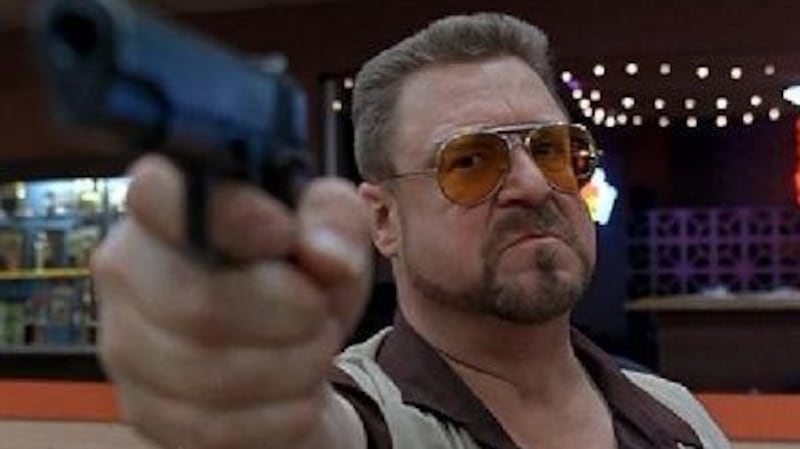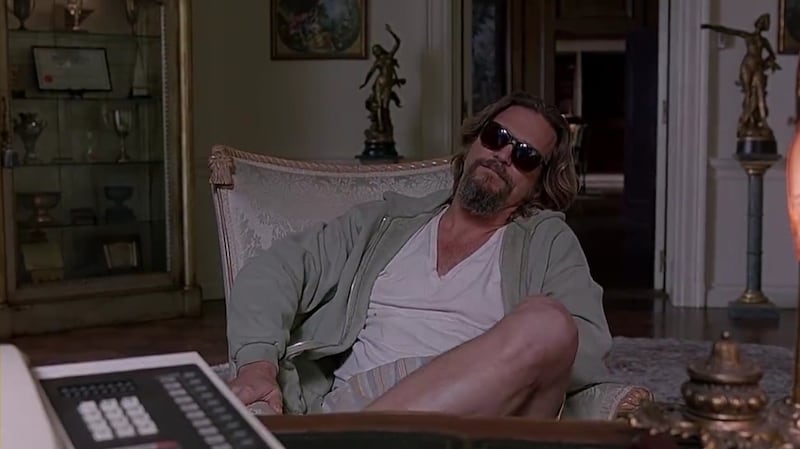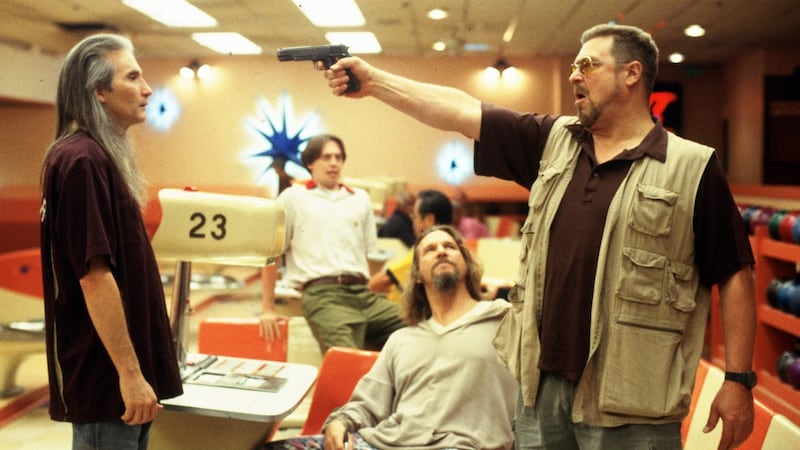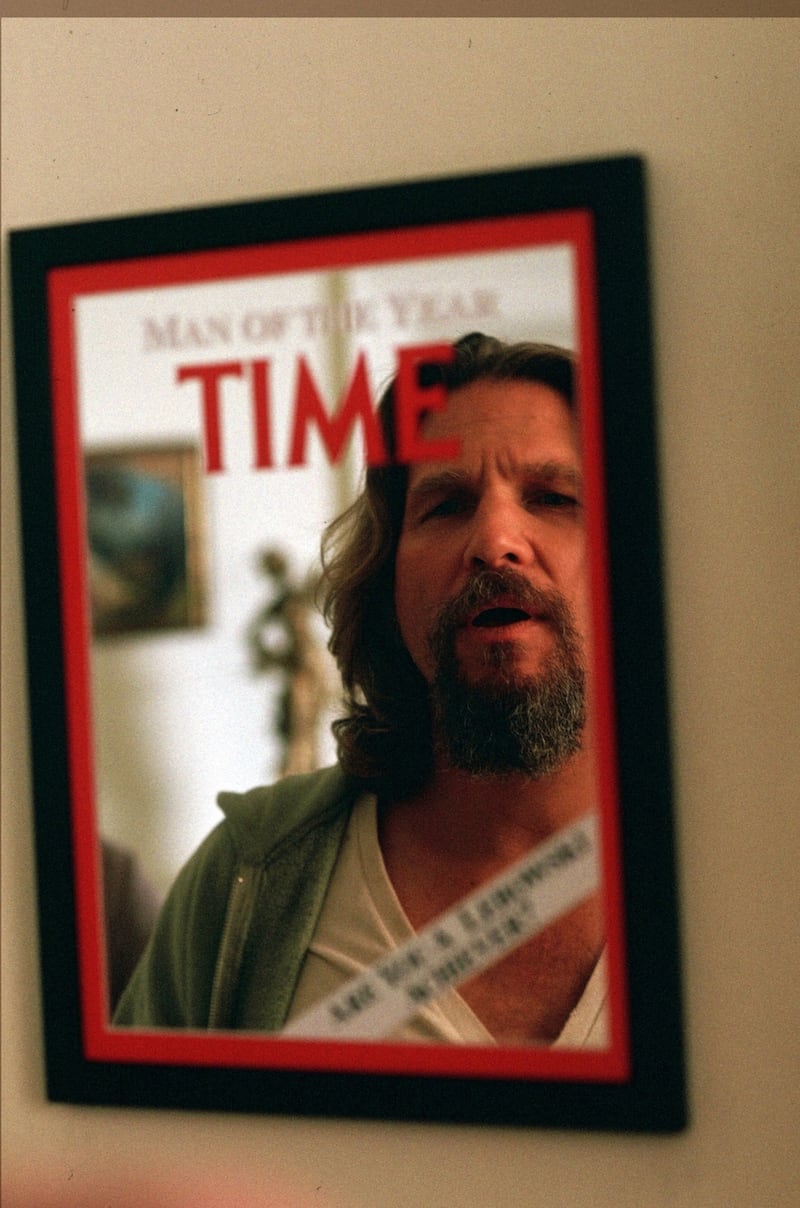There are currently more than 450,000 ordained Dudeist priests worldwide, espousing the belief that “…everything is just, like, your opinion, man”. In Reykjavík, you can wash down the Other Lebowski – a sizeable tenderloin steak burger – with a White Russian. Need a present for your “special lady friend”? You won’t have to look too hard online to find a T-shirt with the words “Special lady friend”. At the time of writing, the Lebowski Fest is winding down in Chicago, with an outdoor screening and live music by Creedence Clearwater Revival tribute band The Fortunate Sons. The festival, which originated in Louisville, Kentucky, in 2002, has subsequently been held several times every year in more than 30 cities, including London and Edinburgh.
Twenty years after The Big Lebowski opened with minimum fanfare in cinemas, the Coen brothers' most beloved film is back on the theatrical circuit, now with more fans than ever. To be fair, the film has always had admirers and it was by no means a complete flop first time around. True, it scared up just $17million on a $15million budget in the US, but fared rather better elsewhere, bringing its global tally to $46,189,568.
It was, however, a source of puzzlement for many viewers. Arriving on the heels of Joel and Ethan Coen's Academy Award-winning Fargo, The Big Lebowski's strange comic collage of tropes from the western, noir, pornography and buddy pictures left many contemporaneous critics baffled.

Writing for the Toronto Star, in a review he has subsequently recanted, Peter Howell suggested that: "It's hard to believe that this is the work of a team that won an Oscar last year for the original screenplay of Fargo. There's a large amount of profanity in the movie, which seems a weak attempt to paper over dialogue gaps." The Guardian was even more dismissive: the film is "a bunch of ideas shoveled into a bag and allowed to spill out at random. The film is infuriating, and will win no prizes."
Stoner caper
By 2008, 10 years after its initial bow, The Big Lebowski had made $40 million on American DVD sales alone and was profiled in Rolling Stone under the heading: "The Decade of the Dude: How the Coen brothers' 1998 stoner caper became the most worshipped comedy of its generation."
It's a cult by any definition, not least Umberto Eco's account in his 1984 essay Casablanca: Cult Movies and Intertextual Collage: "The work must be loved, obviously, but this is not enough. It must provide a completely furnished world so that its fans can quote characters and episodes as if they were aspects of the fan's private sectarian world, a world about which one can make up quizzes and play trivia games whose adepts recognise each other through a common competence."
These adepts even have a name: “The Achievers.”
It undoubtedly helps that the film has a pretty funny premise. A slacker noir about a laissez-faire stoner called The Dude (Jeff Bridges) — “or, uh His Dudeness, or uh Duder, or El Duderino, if you’re not into the whole brevity thing” – the film largely unfolds at a bowling alley where The Dude and his teammates, including dopey Donnie (Steve Buscemi) and permanently enraged Walter (John Goodman) must face such opponents as convicted sex offender Jesus Quintana (a none-more-purple John Turturro) if they are to win a hotly contested tournament. When, in a case of mistaken identity, nihilist goons beat The Dude up, threaten to cut off his “Johnson”, and urinate on his rug, he seeks out the real target, namely the Other Lebowski (David Huddleston) a crippled millionaire with a young trophy wife named Bunny (Tara Reid).

In his quest to replace the rug, which as Walter reminds him, "really tied the room together", The Dude is drawn into a playful plot with a "lotta ins, lotta outs, lotta what-have-yous". Having been dispatched by the 'Other Lebowski' and his unctuous assistant (Philip Seymour Hoffman) to track down the apparently kidnapped Bunny, The Dude is knocked unconscious several times, leading to surreal sex and bowling-themed dream sequences, shot with no little elan by Roger Deakins.
Trotskian positionality
Never mind the cosplay and the many, many memes generated from this scenario. High-falutin' fans can always luxuriate in The Year's Work in Lebowski Studies, a 2009 collection of academic papers edited by Edward P Comentale and Aaron Jaffe, in which literature professor Craig N Owens argues that the Dude represents "Trotskian positionality."
Why? Because the White Russian references Leon Trotsky's part in defeating the White Russians and, by way of Kahlúa, recalls his flight to Mexico. In the same book, Joshua Kates's essay The Big Lebowski' and Paul de Man: Historicizing Irony and Ironizing Historicism discusses the link between The Dude and the 1960s, or more accurately "…not the 1960s themselves but a certain reception and interpretation of this period in the 1970s as (The Dude's) actual socio-cultural reference point."
He may be on to something. Speaking to this paper in 1998, Ethan Coen acknowledged The Big Lebowski's relationship with Robert Altman's The Long Goodbye. "We definitely know that movie," he said, "and we were thinking about it in a way when we were making this." Taking cues from Elliott Gould's incomparable Marlowe in The Long Goodbye, the Coen brothers take the conceit one step further. In The Big Lebowski it's not just the stoner protagonist that looks like a man out of time; it's everybody and everything.

The "strongly vaginal art" of Maude Lebowski (Julianne Moore) was inspired by Meat Joy, the seminal 1964 work by feminist performance artist Carolee Schneemann. The very 1980s nihilists, led by Uli Kunkel aka Karl Hungus, were once part of the Kraftwerk-alike Autobahn, an electro-pop act who released one album, Nagelbett ("Bed of Nails") in the late 1970s. The porn magnate Jackie Treehorn (Ben Gazzara), is another 1970s throwback. Save for the wheels, Jon Polito's Volkswagen-driving private dick might actually pass for one of Philip Marlowe's contemporaries. Walter, meanwhile, clings to a long-dissolved marriage to a Jewish wife and memories of the Vietnam war.
Gulf war
The film itself is set during the first Gulf war – a conflict Walter dismisses as “a bunch of fig-eaters wearing towels on their heads, trying to find reverse in a Soviet tank” – some five years before it went into production. As Sam Elliott’s moustachioed and (in common with everyone else) anachronistic cowboy narrator notes: “Now this here story I’m about to unfold took place back in the early nineties, just about the time of our conflict with Saddam and the Iraqis. I only mention it because sometimes there’s a man … for his time and place.”
The Big Lebowski, accordingly, makes space for President George HW Bush's famous "this aggression cannot stand" speech, which The Dude later parrots at his millionaire namesake.
Saddam Hussein later appears in The Dude's trippy, musical dream after his White Russian is spiked. The Canadian academic Daniel Keyes probes the film's knotty relationship with the Gulf conflict in the 2014 paper The Big Lebowski: The Gulf War and Mediated Memory, noting that Bush the Elder's deliberate mispronunciation of Saddam (with a stress on the first syllable) – translating into "shoe-shine boy" in Arabic – is visually reflected in The Dude's dream, wherein the Iraqi leader is seen shining shoes at the bowling alley.
Kuwait surrogate
Indeed the rug, or possibly the bowling tournament, may be a Kuwait surrogate. After The Dude expresses his displeasure at Walter for pulling a gun on rival bowler Smokey, the Vietnam veteran snaps back at his friend: “Pacifism is not ... Look at our current situation with that camel fucker in Iraq. Pacifism is not something to hide behind.”
The Bush-Dude aggression address is just one of many duplicates, doubles and ripostes that make The Big Lebowski more rewarding with multiple viewings. Key and much-loved phrases are repeated throughout: "In the parlance of our time" is used by both Maude and The Dude; "abide" is used by The Dude and his similarly-named sometime employer. We already know that The Dude hates The Eagles when we see Turturro's Jesus bowling suggestively to a Gipsy Kings Spanish-language over of that band's Hotel California.

There is more endlessly quotable dialogue, of a kind that ends up on T-shirts. “It increases the chances of conception.” “This is not ’Nam. This is bowling. There are rules.” “He fixes the cable?” Even young Larry’s essay on the Louisiana Purchase – Larry is most definitely flunking social studies – is well worth a read. All those phrases certainly tie the movie together.
The Big Lebowski 20th Anniversary Screening and Party is at the Light House Cinema and Pálás Cinema on September 22nd
RANDOM LEBOWSKI FACTS
– Several characters have real-world equivalents. The Dude is based on Jeff Dowd, who helped distribute the Coen's first film, Blood Simple, in 1984; Peter Exline, a screenwriting consultant and film professor at USC, pioneered the phrase "tied the room together";
– Tara Reid had a toe double in the film and was cast as Bunny ahead of Charlize Theron, who auditioned for the role.
– The Coen Brothers generally refuse to discuss the film, but in 2016 they refuted the internet’s enduring theory that Donny is just a figment of Walter’s imagination, a hypothesis rooted in the fact that The Dude has no interactions with Steve Buscemi’s character and the fact that Donny’s bowling shirts all feature different names. Speaking to the Huffington Post, Ethan Coen noted: “But doesn’t The Dude get covered by Donny’s ashes at the end of the movie?”
– Norwegian trailers for the film included the endorsement: "Anbefales av norsk bowling forbund" (Recommended by the Norwegian Bowling Association).
– John Goodman, Steve Buscemi, and John Turturro's characters were written specifically for them. Turturro, who has been keen for a Lebowski sequel for many years, will reprise his role in "spiritual sequel" Going Places, a remake of Bertrand Blier's 1974 French movie co-staring Audrey Tautou and Bobby Cannavale.



















